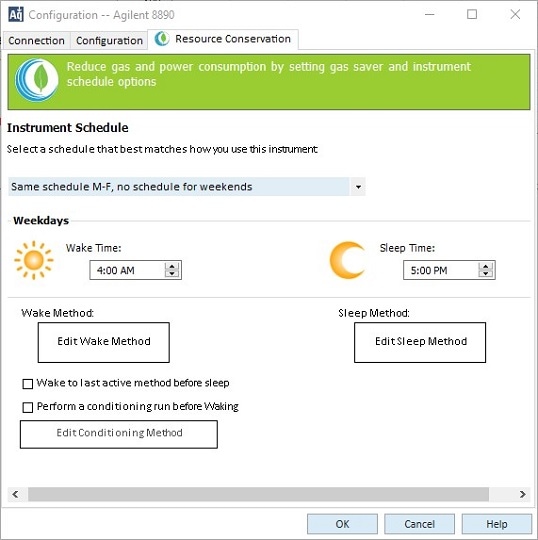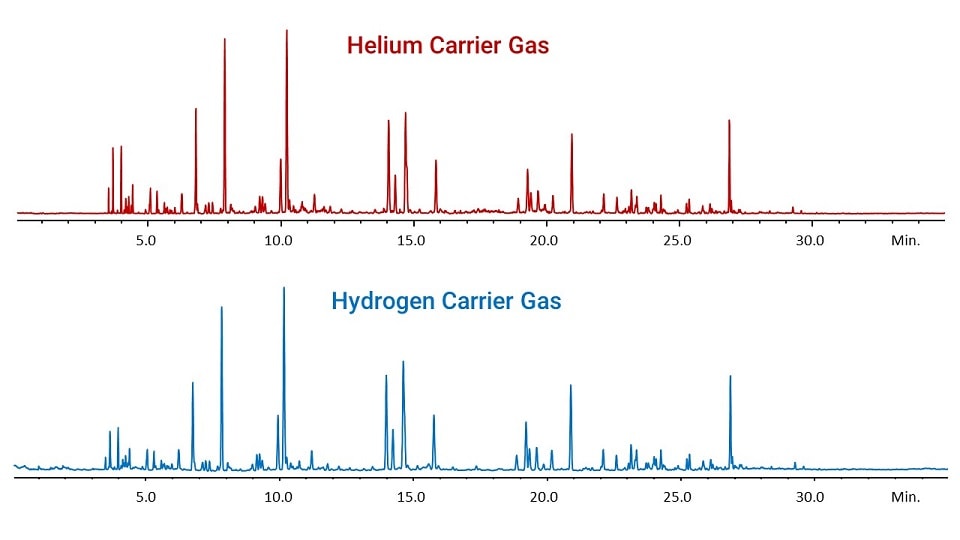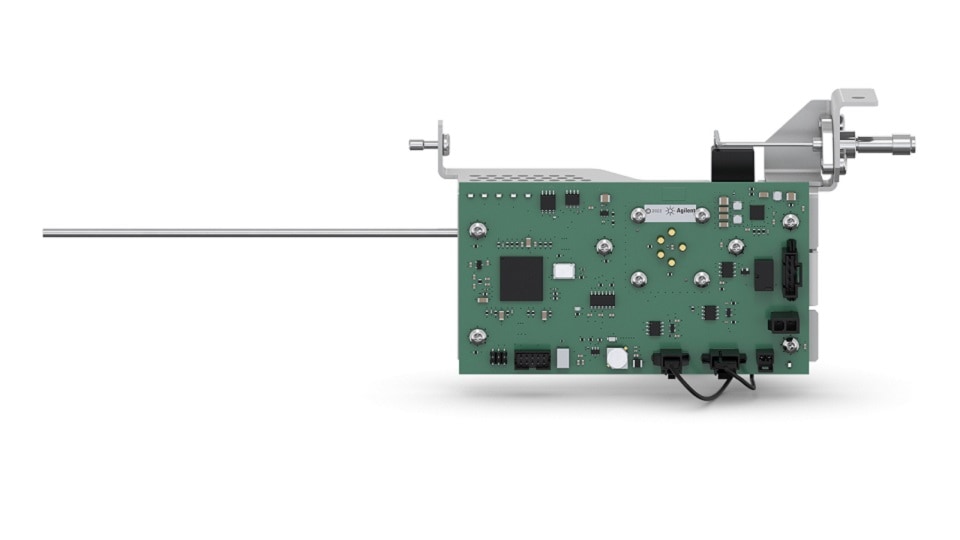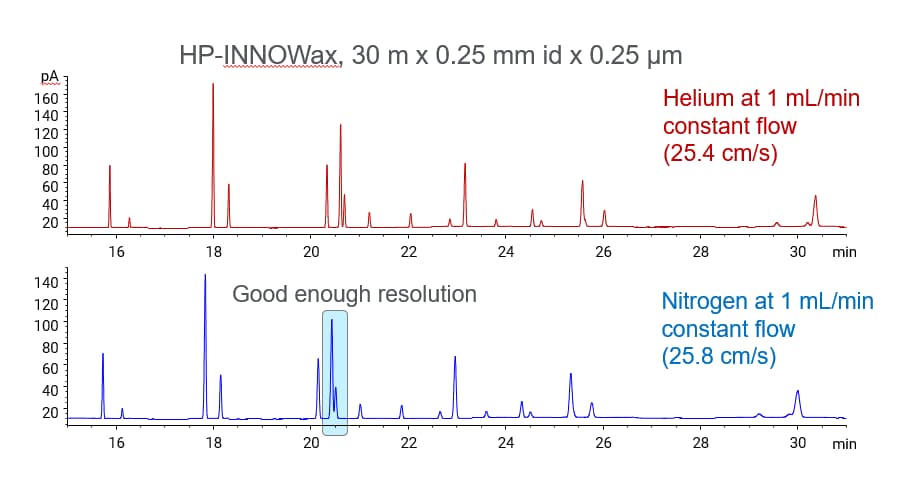Conserve or convert your GC carrier gas
Ongoing helium shortages can cause unpredictability for gas chromatographers. Find the best way for your laboratory to manage price fluctuations and potential delivery interruptions with helium carrier gas for GC analyses.
First, consider whether you really need to use helium as your carrier gas. Regulated methods, SOPs, or high-sensitivity GC/MS methods may require the use of helium. In these cases, helium conservation should be pursued. However, other methods may allow for more flexibility where GC users could convert to hydrogen or nitrogen carrier gas as helium alternatives.
Option 1: Conserve helium
Helium conservation is an easy approach for chromatographers who cannot or do not want to change their GC methods. Try these approaches:
- Take advantage of Gas Saver.
- Utilize the optional programmable helium conservation module for your Agilent 8890, 8860, or 7890B GC.
- Check and maintain your helium infrastructure to prevent leaks.
Agilent Gas Saver works with split/splitless and multimode inlets by reducing the split flow rate at a specified time after the injection while maintaining constant septum purge and column flow rates throughout the GC run. The split flow rate always remains at this lower level except during the injection. Often, the total flow can be reduced by 50% or more by simply using Gas Saver.

The optional helium conservation module should be considered for GC systems that are not running continuously. It automatically switches the carrier gas supply to nitrogen during idle time, keeping the flow path inert and the system at temperature while in standby. This process can be automated with “sleep” and “wake” methods in Agilent OpenLab CDS to prevent interruptions to your GC workflow.
Combining the helium conservation module with Gas Saver can greatly reduce helium consumption when:
- Using split methods
- You can’t change or revalidate your method
- Optimal GC/MS performance is needed
See how much helium you can save in your lab with the Helium Conservation Cost Savings Calculator.
Laboratories, especially those with large helium distribution manifolds, should perform a periodic helium use audit and leak check that could reduce consumption and result in substantial savings. Watch this short video to learn how to do this, and see how an Agilent site employed this approach to reduce helium use by 40%.
For a more in-depth look at helium conservation, check out this webinar.
Option 2: Convert to an alternative carrier gas
To avoid any disruptions caused by helium shortages, think about whether an alternative carrier gas would be possible for your analyses. Are you using GC or GC/MS? If GC/MS, consider hydrogen carrier gas. However, if you are doing GC, more options are available. If your method resolution is more than sufficient, try nitrogen. If it is resolution-critical, try hydrogen.
Helium to hydrogen conversion
Methods that will generally require less optimization include analytes that are:
- “Durable” compounds
- At higher concentrations
- Analyzed with split injections
- Derivatized
 ASTM D5769 – GC/MS analysis of aromatics in gasoline
ASTM D5769 – GC/MS analysis of aromatics in gasoline
When converting from helium to hydrogen carrier gas, allow time for necessary updates to SOPs and validation.
There are a few considerations when using hydrogen as a carrier gas.
- There are flow limitations with MS pumping capacity, so a turbo pump is recommended.
- Peak elution orders and column sample capacity may change slightly.
- Hydrogen may interact with analytes and the sample flow path, so an inert column and flow path are recommended. Lower inlet temperatures can reduce the chance of hydrogen reacting with the system.
- Certain solvents, such as methylene chloride and carbon disulfide, should be avoided.

Using hydrogen carrier gas for GC/MS analysis does not work well with semi-volatile organic compounds, pesticides, and other active compounds. The Agilent HydroInert source is designed to improve chromatographic efficiencies with hydrogen, allowing you to:
- Maximize your return on investment for hydrogen carrier gas
- Achieve faster, shorter separations
- Reduce sensitivity loss and spectral anomalies
- Minimize downtime caused by system maintenance and ion source cleaning
Learn more about the capabilities of the HydroInert source in this informative technical overview.
Get detailed instructions on converting your Agilent EI GC/MS system from helium to hydrogen carrier gas. While this user guide focuses on GC/MS, it also includes many useful tips for any GC user considering switching to hydrogen carrier gas.
Agilent GC and GC/MS systems offer built-in hydrogen safety features. In the event of a hydrogen leak, the system will perform a series of actions including opening the exhaust flaps, turning off the hydrogen gas supply, shutting down thermal zones, and displaying a message on the front panel (with alarm tone) alerting of a safety shutdown.
The optional Hydrogen Sensor Module Series 2 for 8890 and 8860 GC systems checks for free hydrogen in the GC column oven that may come from leaks in the flow path. When properly calibrated, the sensor monitors the free hydrogen level in the oven and will trigger a shutdown of all hydrogen gas flows before the hydrogen level in the oven reaches 1% — well below the limit that may pose a risk.

More considerations for GC and GC/MS users working with hydrogen gas are outlined in the Agilent GC/MS Hydrogen Safety user manual and technical overviews for the Intuvo 9000, 8890, and 8860 GC systems.
Switch from helium to nitrogen carrier gas
Nitrogen often gets a bad reputation as a GC carrier gas due to reduced resolution. But when method resolution is more than adequate with helium, nitrogen carrier gas can provide a good separation without the supply and cost issues of helium or the safety concerns of hydrogen.

GC analysis of FAME content in biodiesel by EN14103
Method translation for your alternative carrier gas
Need help converting your existing helium-carrier method to hydrogen or nitrogen carrier gas? Check out the method translation software that is built into OpenLab CDS software or can be downloaded as a standalone application. Using your existing helium method parameters, this tool will automatically suggest new pressure, flow, velocity, and temperature program rates for hydrogen or nitrogen, ensuring virtually identical relative retention order.
Learn more about alternative carrier gases from Agilent experts in this webinar.
Comparing carrier gas options
Carefully consider all your options when choosing a carrier gas for your GC or GC/MS method.
| Helium Carrier Gas | Hydrogen Carrier Gas | Nitrogen Carrier Gas | |
|---|---|---|---|
| Pros |
|
|
|
| Cons |
|
|
|
Source: https://www.agilent.com/en/products/gas-chromatography/gc-systems/handle-the-helium-shortage

